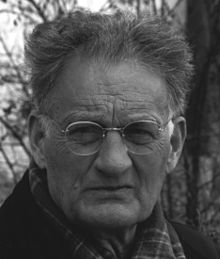Christian Farenholtz
Christian Farenholtz (born February 27, 1923 in Magdeburg ) is a German architect and urban planner .
Life
Christian Farenholtz was born as a merchant's son in Magdeburg in 1923 . He has five children from his first marriage and is married to Sabine Rheinhold for the second time.
Act
In his work in the State Planning Office in Hamburg from 1954 to 1965, he called for a political perspective on planning and placed great emphasis on the mediation and participation of people in planning processes. During this time he worked, among other things, on two plans, Neu Altona and City Nord , in which he expressed his basic convictions on urban development and planning. Neu Altona was about reconstruction planning. It showed the avoidance of closed, narrow blocks and instead represented an open arrangement of the buildings with connecting green spaces between the houses. This is how residential quarters were created that are still of high quality today. As part of the planning for City Nord, a new location for individually designed administration buildings was created.
From 1965 to 1973 Christian Farenholtz was building mayor in Stuttgart . He was also a member of the German Council for Urban Development and thus had a large share in the development of the Urban Development Promotion Act (StBauFG), which later found its way into the Building Code ( BauGB ). In connection with the Urban Development Act, the simulation game was also introduced as a planning tool, thus enabling all those concerned to participate in the planning.
He then worked for 7 years, from 1973 to 1980, in Hamburg at GEWOS (Institute for Urban, Regional and Housing Research). With his help, urban development plans for Hameln , Itzehoe and Osnabrück were drawn up . In addition, thorough housing market analyzes and social studies as well as the evaluation of the StBauFG were carried out.
From 1980 Christian Farenholtz was a professor at the Technical University of Hamburg-Harburg ( TUHH ) and worked here on the development of the urban development / urban planning course . In 1988 his time at the TUHH ended.
Subsequently, he made policy advice for the federal government, states and municipalities and was also involved in the alignment of building laws in the FRG / GDR .
Publications
- Contributions to the discussion on the subject of the city. 1971. (online)
- with Hartmut Dieterich and Friedrich-Otto Blumers: Urban development law for practice: legal text and systematic presentation of the practical procedure of renovation and development measures. 1972. (online)
- City and traffic: for the future development of settlement and traffic structures: Study by the Society for Housing and Settlement eV Hamburg (GEWOS). 1977. (online)
- with Max Bächer and Alain Trapenard: New tasks for the city: Platz u. Building as a contribution to preservation and Design d. Inner cities. Verlag Christians Hans, 1978, ISBN 3-7672-0545-9 . (on-line)
- Effects of the permit requirement for the division of developed land on the conversion of rental apartments into residential property. IRB-Verlag, 1979. (online)
- with Andreas Pfadt: Self- determination and external determination in social housing. 1981. (online)
- with Manfred Fuhrich: Municipal housing policy: municipal housing subsidies for economically and / or socially disadvantaged households. 1982. (online)
- with Mario Bloem, Dorle Danne and Jens Usadel: Development concept downtown Magdeburg. 1996. (online part 1 , part 2 , part 3)
- Tradition and topicality: the history of the Justus Brinckmann Society eV 2002. (online)
Honor and distinction
Individual evidence
- ↑ GEWOS . Website of the Institute for Urban, Regional and Housing Research GmbH. Retrieved January 9, 2013.
- ↑ Cornelius Gurlitt Memorial Coin 2012 , accessed on January 20, 2013.
swell
- Literature by and about Christian Farenholtz in the catalog of the German National Library
- dasl-nord.de
| personal data | |
|---|---|
| SURNAME | Farenholtz, Christian |
| BRIEF DESCRIPTION | German architect, urban planner and university professor |
| DATE OF BIRTH | February 27, 1923 |
| PLACE OF BIRTH | Magdeburg |
